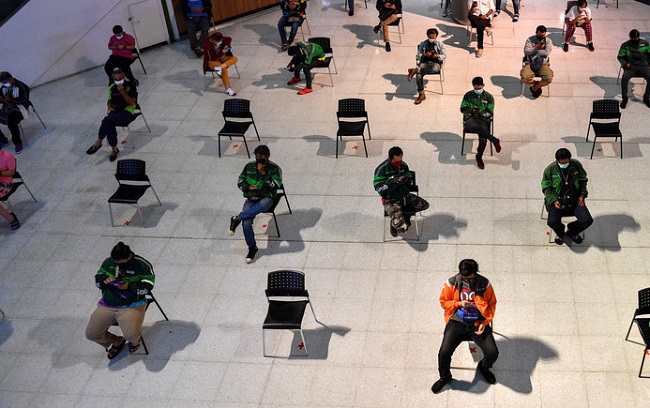Social distancing is defined by the CDC as “methods for lowering frequency and closeness of contact between persons in order to lessen the risk of disease transmission.” The World Health Organization defined social distance as “maintaining at least an arm’s length distance from people, [and] reducing gatherings” during the 2009 swine flu epidemic.
The Centers for Disease Control and Prevention (CDC) described social distancing as “staying away from crowds and large gatherings” during the 2009 COVID-19 pandemic.

What is Social Distancing
Social distancing, also known as physical distancing, is a set of non-pharmaceutical interventions or measures used in public health to prevent the spread of a contagious disease by keeping people at a distance from one another and decreasing the frequency with which they come into close contact with one another. the most famous act of social distancing.
It typically entails avoiding big gatherings of people and keeping a specific distance from them (the distance recommended varies from nation to country and can alter over time). Reducing the likelihood that an uninfected individual may come into touch with an infectious one can slow the spread of disease and save lives.
Good respiratory hygiene, face masks, and hand washing are only few examples of other precautions that can be taken alongside these.
Read Also:
- Is Dove Cameron Dating a Girl
- Christopher And Stephanie Go Big Show Why Did they Leave
- 1935 Silver Certificate Dollar Bill Without in God We Trust
‘Walden’ May be the Most Famous Act of Social Distancing. It’s Also a Lesson on the Importance of Community
A timid young man named Henry David Thoreau “went to the woods to live intentionally” in 1845. Along with some companions, he constructed a modest cottage close to Concord, Massachusetts’s Walden Pond using discarded planks from a nearby shack.
He lived there for over two years, “sucking out all the marrow of existence,” in an effort to overcome a spell of writer’s block. Some snarky teenager will inevitably point out that he did not spend his time alone during this period.
And yet, Thoreau’s experiment, written about in “Walden; or, Life in the Woods,” is the most well-known example of social isolation in the history of the world. Tens of millions of us have started something akin to Thoreau’s retreat since the coronavirus quarantine began in the United States last month, except with a better Internet connection.
The difficulty of keeping isolated will undoubtedly increase as the number of days, weeks, and months accumulates. That location was explored by Thoreau before we got there. He was well aware of the fact that it is possible to be happy all on one’s own, as well as to feel lonely amidst other people.
What ‘Walden’ Can Tell us About Social Distancing and Focusing on Life’s Essentials
In an effort to stem the spread of the coronavirus, governors and mayors have ordered millions of citizens to stay inside. If you’re at a loss for what to read next, there are countless recommendations online for works dealing with isolation, famine, and other catastrophic events.
But, a book that deals with both of these topics is surprisingly hard to come by. Being the author of three volumes on the life of writer, poet, and philosopher Henry David Thoreau, I can confidently claim that “Walden,” Thoreau’s 1854 description of his time spent living “alone” in the woods near Concord, Massachusetts, is a must-read. To clarify, Thoreau wasn’t as lonely at Walden as he was in town.
He regularly entertained passers-by with social theater performances that involved hoeing a bean field. The philosophical book on self-reliance and a pivotal text in the American literary canon, “Walden” has been published in over a thousand editions and translated into dozens of languages, making it the spiritual forerunner of the modern environmental movement.
The New Untouchability Act: Social distancing, Madi and Aacharam in the Time of Coronavirus
More than a thousand people perished in three separate fires at a theater, a nightclub, and a school in the United States almost a century ago, prompting stricter building rules throughout the country.
Lawmakers passed regulations to reduce fire risk and casualties, such as prohibiting the use of combustible materials in theaters, enforcing seating capacity, requiring buildings to have designated egress doors and windows, and requiring exit signs to be visible at all times (even when there is no electricity).
One of the easiest modifications was to mandate outward-swinging exit doors in all public buildings across the United States. Revolving doors are now required to have at least one conventional, outward-swinging door on either side of them, per new regulations. These codes are in use now all throughout the globe.
The Historical Context of the Black Death
The Black Death was one of the deadliest pandemics in human history, arriving in Europe around 1347 and lasting until the early 1350s. It is estimated to have killed 30-60% of Europe’s population at the time. The disease, caused by the bacterium Yersinia pestis, was transmitted through fleas on rats, though this was not known at the time.
Social Distancing During the Black Death
In response to this devastating pandemic, various forms of social distancing were instinctively adopted:
- Quarantines: Cities and towns began to implement quarantine measures. One of the most famous examples is the Venetian-controlled port city of Ragusa (modern-day Dubrovnik, Croatia), which in 1377 mandated a 30-day isolation period (trentino) for all incoming ships and travelers. This period was later extended to 40 days, known as a quarantine.
- Isolation of the Sick: Infected individuals were often isolated from the rest of the population. Houses with infected members were marked, and in some cases, victims were forcibly removed to pest houses.
- Suspension of Social Gatherings: Public gatherings, including church services and market days, were limited or canceled to prevent the spread of the disease.
Impact of Social Distancing Measures
The implementation of these early forms of social distancing had a significant impact:
- Slowing Disease Spread: While rudimentary by today’s standards, these measures helped slow the spread of the plague in certain regions.
- Economic and Social Impact: Quarantines and isolation had far-reaching effects on trade, economy, and the social fabric of communities.
- Psychological Effects: The fear of contagion and the isolation of social distancing measures had profound psychological effects on people.
Comparisons to Modern Social Distancing
The COVID-19 pandemic has seen the reimplementation of many of these centuries-old social distancing measures. Modern technology and medical understanding have refined these tactics, but the core concept remains the same: reducing close contact to control the spread of disease.
Lessons from History
The Black Death’s example of social distancing offers several lessons for contemporary society:
- Importance of Public Health Measures: It underscores the critical role of public health interventions in controlling pandemics.
- Social and Economic Balancing: The need to balance disease control with social and economic impacts.
- Public Cooperation and Compliance: The effectiveness of social distancing hinges on public understanding and compliance.
FAQs
- Was social distancing effective during the Black Death? While primitive, social distancing measures did have some effectiveness in slowing the spread of the plague in certain areas.
- How did people communicate during social distancing in the past? Communication was limited to written correspondence and messengers, as opposed to today’s digital communication methods.
- What was the long-term impact of the Black Death on society? The Black Death had profound long-term effects, including changes in economic structures, labor practices, and a shift in social norms and attitudes.
In summary, the historical act of social distancing during the Black Death era provides valuable insights into the enduring nature of this public health strategy. Understanding the past helps us appreciate the efforts and challenges faced in modern times, reminding us that while the context changes, the human spirit of perseverance and adaptation remains constant.
Read Also:
- Will There be a Season 4 of Shooter
- My Hero Academia Season 5 Hulu
- The Punisher Season 3 Release Date
Conclusion
The phrase “social distance” was coined in response to the Covid 19 pandemic when it became apparent that isolation was one of the few effective ways to prevent the transmission of the virus. What broader ramifications this could have for a civilization where social separation had been practiced for over two millennia was a mystery to commentators at the time.
It was not illogical to assume that this new practice would have repercussions for Indian society, particularly because Untouchability is the defining characteristic of Caste.


